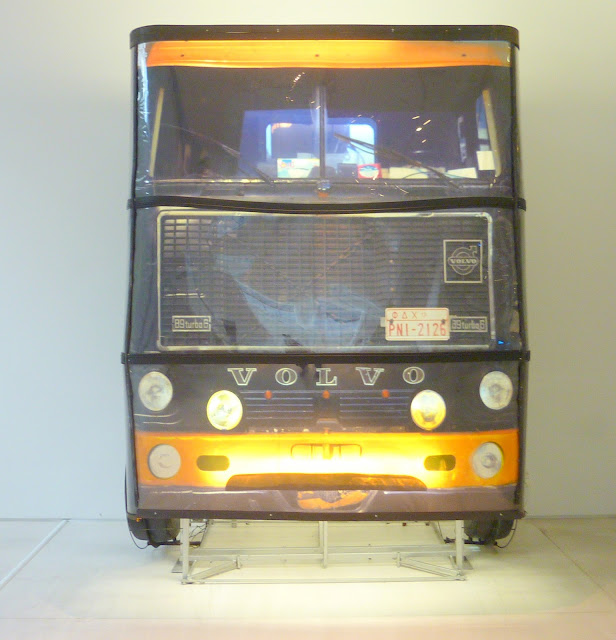Museum of Contemporary Art (EMST) in Athens, new acquisitions.
Even though the museum is not fully operational yet - they say it will take at least another year - there is an exhibition of some of their new acquisitions at the moment, and last week we went to have a look.
The museum was full of school groups when we visited. This year 1 group were delightful: interested, engaged and beautifully behaved.
George Lappas, Truck, 2001, (photographic membrane, PVC, iron, neon lights)
Piotr Kowalski, Perspective Dhuison, 1970-1997, (photography on canvas with blue neon)
Stathis Logothetis, E273, 1970, (oil on canvas)
Pandelis Chandris, Shadow Cliffs and Eight Ecliptic Full Moons, 2016-2017, (black silk paper, prints on white paper, bamboo covered with silk paper, epoxy mastic)
looking closer
and a group photograph
Eugenia Apostolou, Disembodiment, 2012, (oil on canvas)
Jannis Kounellis, Untitled, 1967, (steel, wood, paraffin lamp)

Nikos Tranos, A Glacier at our Table, 2013, (glazed clay, wooden table)
This sculpture refers to the idea of the nuclear winter, i.e. the climate conditions expected to prevail on the planet in the case of an extended nuclear war. The bright pink mutant forms are made in the colour of the hospital section where the victims of radiation poisoning were treated after the nuclear disaster at the Daiichi power plant in Fukushima. Despite the fairytale image it presents at first glance, the work comments on our complacency.
looking closer
Joanna Hadjithomas and Khalil Joreige, I Stared at Beauty so Much, 2013, Waiting for the Barbarians, (animated photographs, video, sound, HD format)

Andreas Lolis, Shelter, 2013-16, (marble)
The work is part of a seascape series in which the artist depicts the spots in the Mediterranean where refugees' boats have sunk. Starting from his home town in Kalamata, Tzamouranis visited these locations seeking an experiential relationship. Then, with the help of photos and drawings, he attempted to convey on his canvas the whole of the human tragedy through the image of the black, stormy sea, ready to engulf every trace of human life. In the works' titles he gives the exact coordinates of the wrecks.
Alexandros Psychoulis, Monument for the Things That Change, 2014, (plastic cord, metal frame)
This work focuses on the 'Greek language issue' and more specifically, on the so-called 'atheist' trial, the trial of Alexandros Delmouzos, head teacher of the Volos School for Girls in Nafplion in 1914. Delmouzos was accused of spreading atheism and moral corruption because he was using pioneering teaching methods where the Demotic (colloquial) language was used. Reactions from the clergy and conservative members led to a trial.
Costas Varotsos, Untitled, 2017, (digital print on glass)
The installation consists of the flags of the 27 countries, members of the European Union. Having created the glass floor map, the artist then broke it - a comment on the differences that divide today's Europe, as well as on the displacement of people from one country to another.
You can see more of Varotsos' work here and here
looking closer.
Bertille Bak, Rayonnage, installation, 2009-2014, (wool on canvas, iron structure, six needlepoints)
Ziad Antar, WA, 2004, video
We had great fun watching this delightful video of the two children singing Waaa
Chrysa, Untitled, (aluminium, red colour, neon)






























No comments:
Post a Comment